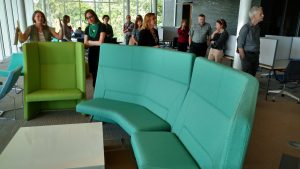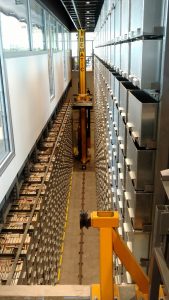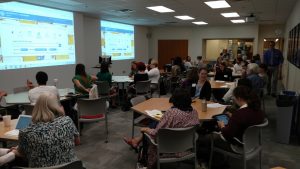by Steven Bell, Associate University Librarian
At approximately 7:00 a.m. on Wednesday, August 17, 2016, a group of 19 staff members from Temple Libraries left Paley Library for a visit to meet colleagues at the Marywood University Learning Commons. We were eager to see and hear about this relatively new facility and in particular, to see their Automated Storage and Retrieval System live and up close. While there are now about 20 U.S. libraries with an ASRS, the installation at Marywood is the closest to Temple University.

photo courtesy Steven Bell
The Learning Commons has been open for just over a year. It is a 3-story, 77,000 square foot building that was a $43 million project. The old library will be torn down as its design was not hospitable to re-purposing. The primary partners in the building are the Office of Information Technology, the Teaching & Learning Center and the campus radio and television stations (on the lower level in impressive space).
While they would have wanted to include the writing and tutoring centers, there was not enough space, but they plan to invite them in to have on-site tutoring hours. Most of the funding for the building resulted from a university capital campaign. As no donor has yet come forward, the building goes unnamed for now (you can name it for a mere $7 million dollars).
After an introduction to Marywood University Learning Commons, from Library Director David Schappert, we broke into two groups. One group learned about the ASRS while the other group took a tour, learned about the transition to the new Learning Commons and discussed library services in the new facility. The groups reversed in the afternoon.
The ASRS currently holds 190,000 volumes. It stores every book that was on the overcrowded shelving in the old library, yet thanks to the high-density storage the ASRS is only 60% full. We received a demonstration of the ASRS in action. There are two robots and four sizes of bins. Users find their book in the online catalog and then choose “place hold” to have a book retrieved. The bins we observed were completely packed with books, but they continue to work on optimizing bin contents by size and call number (the math department has been called on for assistance). The OPAC location for a book in the ASRS is “bins”.

photo courtesy Steven Bell
There are several observation windows allowing for views into the ASRS and during our visit we noticed the system getting quite a bit of attention from those in the library. We were told that it is definitely an attraction.
We learned there are two possible arrangements: random and designated. As the former implies books just go into whatever bin is available based only on item size. Marywood chose to go with the designated approach, which is more orderly, because conducting inventories is much easier. They had heard that a few ASRS libraries that started with the random approach eventually transition to the designated model.
We learned much more about (when to charge the item to the user; putting books back in the bins; how to place identifiers on the books for retrieval from the bin) the ASRS than there is space here to share, so if you have questions you should seek out John Oram, who observed that an ASRS runs best with an ASRS nerd in charge of the operation (we are then well positioned for success).
They have observed that students tend to request few books from the ASRS, possibly because they may think they are not allowed to ask for as many books as they’d really like to get. So students tend to ask for 3 or 4 books and then take them all. They’d like to see students get 10 or more books and then take time to decide which of those are the best for their needs. That’s something they will be working on to change that behavior. Overall, since the facility opened circulation is up, mostly because more students are coming to the new library.
The facility has many of the features you would expect to see. Lots of glass and natural light. Thanks to the Learning Common’s location on campus there are excellent views of the surrounding mountains and greenery. The first floor features the Knowledge Bar. It has three areas: IT help desk; circulation and reserve; reference. They learned that students are not able to tell the difference between the services so it leads to confusion and passing students between services. They plan to do more cross training so any staff member can handle the majority of student needs.
The café is a big draw. They thought they might do 300 or 400 sales a day, but on average they do 1,000 sales a day. Not only do more students come in to the Learning Center but they stay longer. The Learning Center is particularly popular with commuter students who prefer the café to the campus cafeteria (fewer but cheaper food options). The café is right opposite the Knowledge Bar so it does create more noise than was expected. There are no quiet zones on the first floor, which is mostly individual seating.
The one percent of the collection that is not in the ASRS is in an area called “Marketplace”. It features a topical book display, new books and leisure reading. Selection for Marketplace is mostly based on publication date; circulation activity is not a selection factor. There are some reference books plus an additional shelving area for art books, as there is a desire for materials with visual appeal. There is also a seed library on the first floor. A re-purposed card catalog holds mostly commercial packets of seeds. They are cataloged and checked out (so to speak – no return necessary). A community garden offers small plots to students who want to grow their own vegetables. Students obtain a plot through a lottery system.
The second and third floors feature more individual and group study spaces, including study rooms. All study rooms are on an online reservation system (they share a campus-wide room reservation system). There are many outlet boxes on the floors. Lockers around the library feature outlets for charging devices. There have been some complaints about noise in study areas so they are considering more individual carrels over the many group chair and table arrangements.
One of the highlights of the building is “The Lobby”, a third floor space featuring a panoramic view of the surrounding mountains. These upper levels also include areas such as Archives and Special Collections, instruction spaces, a large classroom (controlled by the Registrar) and the Teaching & Learning Center. Some of the rooms are used for small receptions and events, but there is no dedicated event space or lecture room. When needed, larger events are held in the close-by performing arts center.
Here are a few other observations we heard about the new building:
- It has become a de facto student center with students wanting to hold different activities in the learning center (e.g., association meetings, raffles, etc). While the attention is appreciated, they are thinking about strategies for how to keep students on using the building for its intended purpose.
- There is a nice staff lounge on the third floor but staff rarely use it. It is possible that in the future it will become a commuter student lounge.
- There is a green roof, but there is no access to it. The building is not yet LEED certified but they are seeking it.
- We observed little permanent signage, not even signs pointing out restrooms (which staff remedied with homemade signs). That has led to many “Where is…” questions. It wasn’t clear why this was the case but they are looking into directory kiosks.
- When they conducted a user survey to get student feedback about the building the comments were mostly about food, HVAC and wireless. There were few comments about library services, study spaces or the sort of things they expected to hear more about.
After a 15-minute wrap-up question-and-answer session, in which Temple staff shared their reactions to the facility, we said our farewell and boarded the bus for the trip home at 3:30 pm. As is the case with our past bus trips to other academic libraries, it was a great learning experience and opportunity to meet some new library colleagues.
Check out more photos from our visit.



